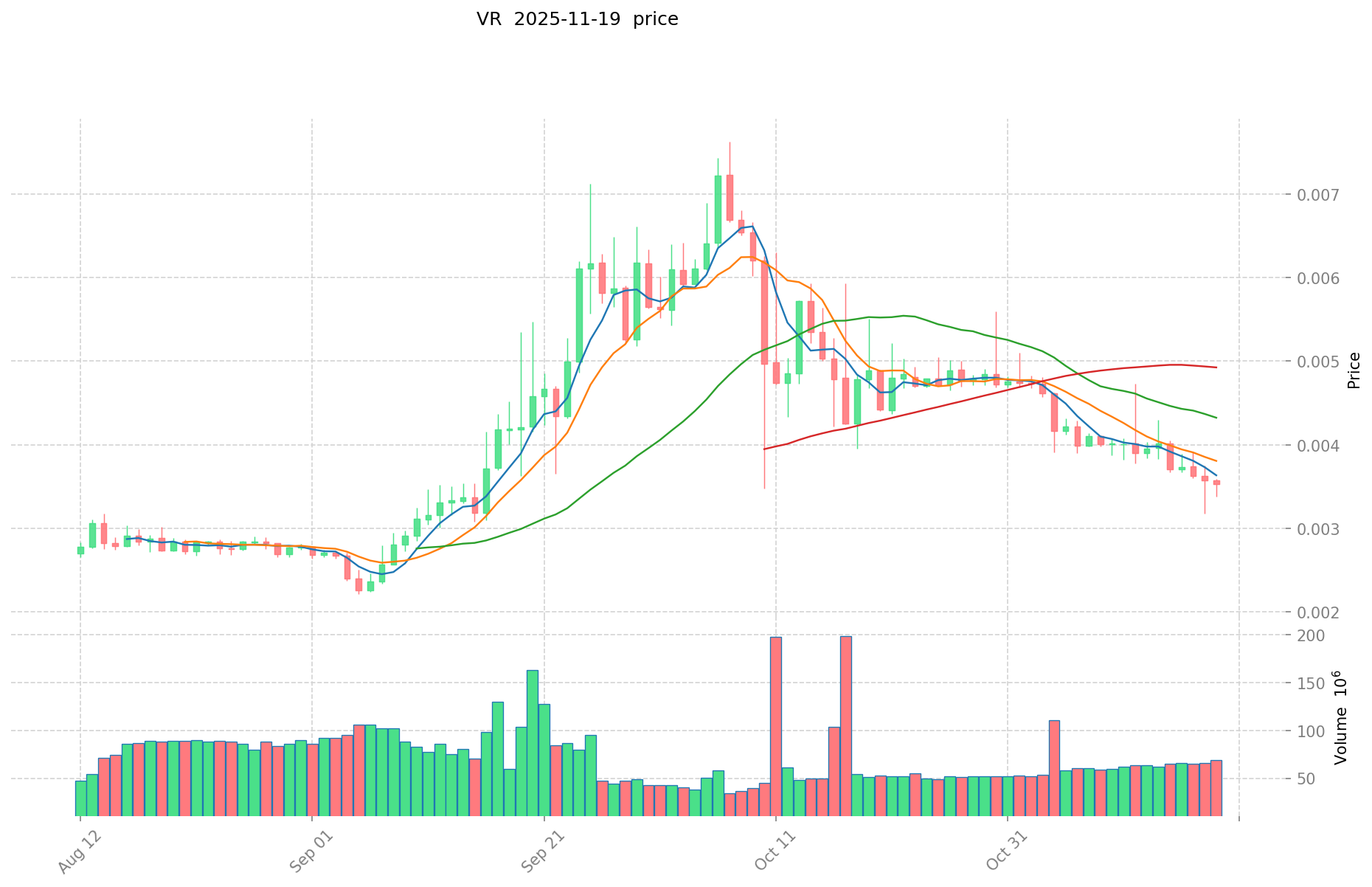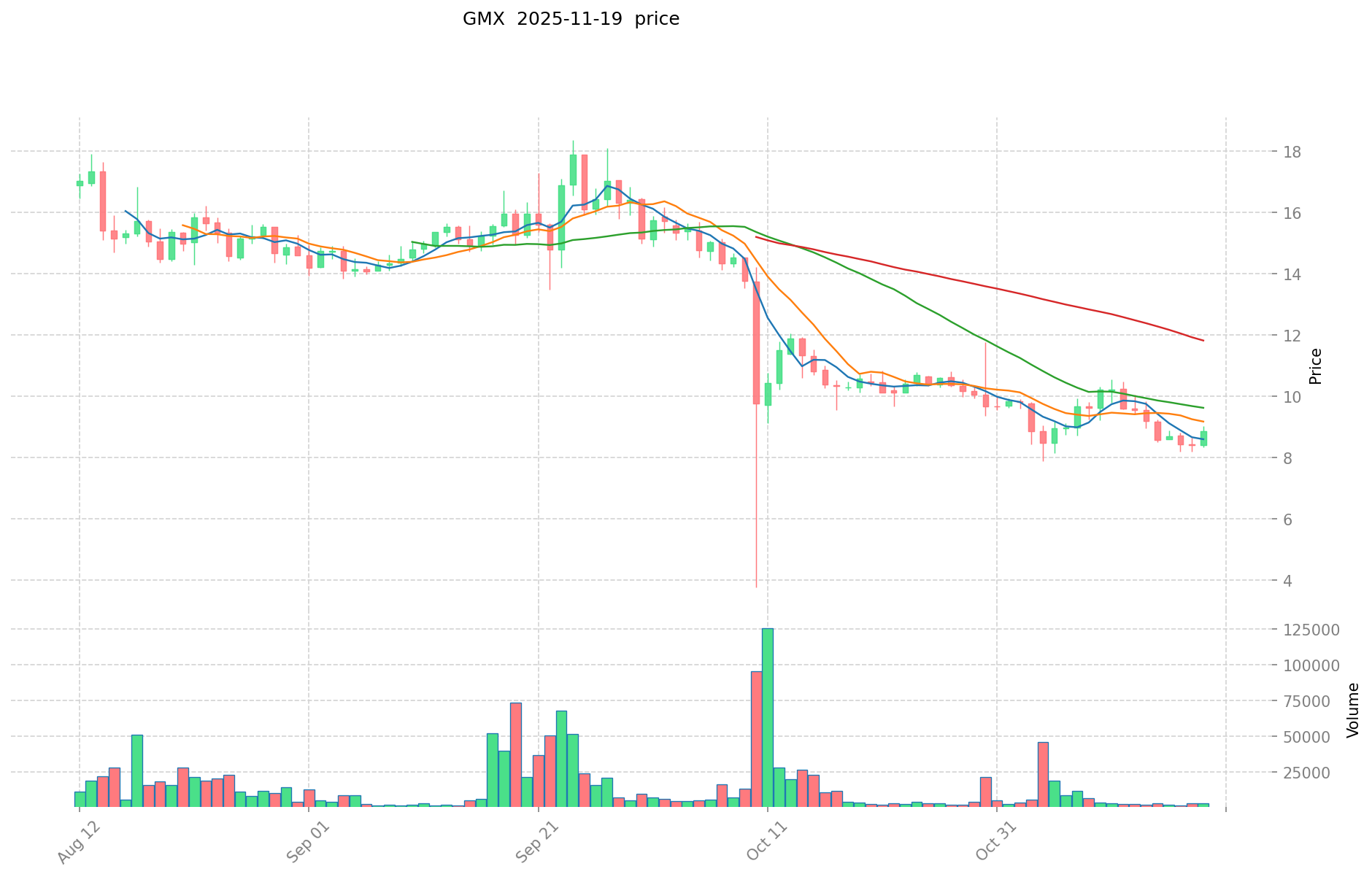VR vs GMX: The Battle for Immersive Gaming Supremacy in the Digital Age
Introduction: VR vs GMX Investment Comparison
In the cryptocurrency market, Victoria VR (VR) vs GMX (GMX) comparison has always been an unavoidable topic for investors. The two not only have significant differences in market cap ranking, application scenarios, and price performance, but also represent different positioning in crypto assets.
Victoria VR (VR): Since its launch, it has gained market recognition for its virtual reality technology and user-created world concept.
GMX (GMX): Since its inception, it has been hailed as a decentralized perpetual exchange, and is one of the cryptocurrencies with utility and governance features.
This article will comprehensively analyze the investment value comparison between Victoria VR and GMX, focusing on historical price trends, supply mechanisms, institutional adoption, technological ecosystems, and future predictions, and attempt to answer the question that investors care most about:
"Which is the better buy right now?"
I. Price History Comparison and Current Market Status
Victoria VR (VR) and GMX (GMX) Historical Price Trends
- 2021: VR reached its all-time high of $0.615957 on December 11, 2021.
- 2023: GMX hit its all-time high of $91.07 on April 18, 2023.
- Comparative analysis: In the recent market cycle, VR dropped from its all-time high of $0.615957 to a low of $0.00222735, while GMX fell from its peak of $91.07 to current levels.
Current Market Situation (2025-11-19)
- VR current price: $0.003541
- GMX current price: $8.878
- 24-hour trading volume: VR $242,225.02 vs GMX $25,861.48
- Market Sentiment Index (Fear & Greed Index): 11 (Extreme Fear)
Click to view real-time prices:
- Check VR current price Market Price
- Check GMX current price Market Price


Core Factors Affecting the Investment Value of VR vs GMX
Supply Mechanisms Comparison (Tokenomics)
- VR: Relies on blockchain technology applications with potential deflationary models
- GMX: Benefits from cryptocurrency market growth cycles with its unique economic model
- 📌 Historical Pattern: Supply mechanisms tend to drive price cycle changes during bull markets where technical innovation, ecosystem expansion, and liquidity cycles create investment opportunities.
Institutional Adoption and Market Applications
- Institutional Holdings: Projects with renowned founders in the digital currency field tend to attract more institutional interest
- Enterprise Adoption: Blockchain technology applications can inject new vitality into traditional financial assets, creating value through innovation
- Regulatory Attitudes: Data protection regulations like GDPR affect consumer experience in different ways across projects
Technology Development and Ecosystem Building
- Technology Innovation: Core value proposition includes user experience as the most critical competitive factor
- Community Development: Creating a "value creation - token deflation - profit sharing" closed loop can help token value rise with ecosystem prosperity
- Ecosystem Comparison: Technical innovation acts as a driving force connecting capital operations with social value creation
Macroeconomic Factors and Market Cycles
- Performance During Inflation: Market structure understanding and technical innovation depth provide resilience
- Monetary Policy Impact: Bull markets typically emerge when technical innovation, ecosystem explosion, and liquidity cycles resonate together
- Data-Driven Decision Making: Efficiency in investment operations influenced by market sentiment and proper valuation metrics
III. 2025-2030 Price Prediction: VR vs GMX
Short-term Prediction (2025)
- VR: Conservative $0.0023062 - $0.003548 | Optimistic $0.003548 - $0.00482528
- GMX: Conservative $4.50942 - $8.842 | Optimistic $8.842 - $12.73248
Mid-term Prediction (2027)
- VR may enter a growth phase, with estimated prices $0.0034853778 - $0.006180736632
- GMX may enter a bullish market, with estimated prices $9.862773532 - $17.199714818
- Key drivers: Institutional fund inflow, ETF, ecosystem development
Long-term Prediction (2030)
- VR: Base scenario $0.007328462828095 - $0.008024832599091 | Optimistic scenario $0.008024832599091 - $0.008940724650276
- GMX: Base scenario $17.814153581271 - $18.822501897192 | Optimistic scenario $18.822501897192 - $22.26769197658875
Disclaimer: The above predictions are based on historical data and market analysis. Cryptocurrency markets are highly volatile and subject to rapid changes. These forecasts should not be considered as financial advice. Always conduct your own research before making investment decisions.
VR:
| 年份 | 预测最高价 | 预测平均价格 | 预测最低价 | 涨跌幅 |
|---|---|---|---|---|
| 2025 | 0.00482528 | 0.003548 | 0.0023062 | 0 |
| 2026 | 0.0051077008 | 0.00418664 | 0.0036005104 | 18 |
| 2027 | 0.006180736632 | 0.0046471704 | 0.0034853778 | 31 |
| 2028 | 0.0078502325982 | 0.005413953516 | 0.0035190697854 | 52 |
| 2029 | 0.008024832599091 | 0.0066320930571 | 0.004244539556544 | 87 |
| 2030 | 0.008940724650276 | 0.007328462828095 | 0.006668901173566 | 106 |
GMX:
| 年份 | 预测最高价 | 预测平均价格 | 预测最低价 | 涨跌幅 |
|---|---|---|---|---|
| 2025 | 12.73248 | 8.842 | 4.50942 | 0 |
| 2026 | 13.2683052 | 10.78724 | 6.6880888 | 21 |
| 2027 | 17.199714818 | 12.0277726 | 9.862773532 | 35 |
| 2028 | 18.9978668217 | 14.613743709 | 9.79120828503 | 64 |
| 2029 | 18.822501897192 | 16.80580526535 | 12.436295896359 | 89 |
| 2030 | 22.26769197658875 | 17.814153581271 | 12.29176597107699 | 100 |
IV. Investment Strategy Comparison: VR vs GMX
Long-term vs Short-term Investment Strategy
- VR: Suitable for investors focused on virtual reality technology and user-created worlds
- GMX: Suitable for investors interested in decentralized finance and perpetual exchanges
Risk Management and Asset Allocation
- Conservative investors: VR: 30% vs GMX: 70%
- Aggressive investors: VR: 60% vs GMX: 40%
- Hedging tools: Stablecoin allocation, options, cross-currency portfolios
V. Potential Risk Comparison
Market Risk
- VR: Highly dependent on the adoption of virtual reality technology
- GMX: Sensitive to overall cryptocurrency market trends and DeFi sector performance
Technical Risk
- VR: Scalability, network stability
- GMX: Smart contract vulnerabilities, liquidity risks
Regulatory Risk
- Global regulatory policies may have different impacts on both tokens, with DeFi platforms like GMX potentially facing more scrutiny
VI. Conclusion: Which Is the Better Buy?
📌 Investment Value Summary:
- VR advantages: Unique positioning in the virtual reality space, potential for growth with VR technology adoption
- GMX advantages: Established presence in the DeFi sector, revenue-generating model
✅ Investment Advice:
- Novice investors: Consider a balanced approach with a slight preference for GMX due to its more established market position
- Experienced investors: Explore a higher allocation to VR for potential long-term growth, while maintaining exposure to GMX
- Institutional investors: Diversify between both, with a focus on GMX for its current utility and VR for future potential
⚠️ Risk Warning: The cryptocurrency market is highly volatile, and this article does not constitute investment advice. None
VII. FAQ
Q1: What are the main differences between Victoria VR (VR) and GMX (GMX)? A: Victoria VR focuses on virtual reality technology and user-created worlds, while GMX is a decentralized perpetual exchange. VR has a lower market cap and price, while GMX has a higher market cap and price. Their use cases and target markets are quite different.
Q2: Which token has performed better historically? A: GMX has shown better historical performance. It reached its all-time high of $91.07 in April 2023, while VR's all-time high was $0.615957 in December 2021. GMX has also maintained a higher price and market cap.
Q3: What are the key factors affecting the investment value of VR and GMX? A: Key factors include supply mechanisms, institutional adoption, market applications, technology development, ecosystem building, and macroeconomic factors. Both tokens are influenced by these, but in different ways due to their distinct use cases and market positions.
Q4: How do the price predictions for VR and GMX compare for the next few years? A: According to the predictions, both tokens are expected to grow, but at different rates. By 2030, VR's optimistic scenario predicts a price range of $0.008024832599091 - $0.008940724650276, while GMX's optimistic scenario predicts $18.822501897192 - $22.26769197658875.
Q5: What are the main risks associated with investing in VR and GMX? A: Both tokens face market risks, technical risks, and regulatory risks. VR's risks are more related to the adoption of virtual reality technology, while GMX's risks are more tied to the overall cryptocurrency market trends and DeFi sector performance. Both face potential regulatory challenges, with GMX potentially facing more scrutiny due to its DeFi nature.
Q6: How should investors approach allocating between VR and GMX? A: The allocation depends on the investor's risk tolerance and investment goals. Conservative investors might consider 30% VR and 70% GMX, while more aggressive investors might opt for 60% VR and 40% GMX. It's important to diversify and consider using hedging tools like stablecoins and options.
Q7: Which token is considered the better buy currently? A: The "better buy" depends on individual investment goals and risk tolerance. GMX may be more suitable for those seeking exposure to an established DeFi platform, while VR might appeal to investors interested in the long-term potential of virtual reality technology. A balanced approach considering both tokens could be beneficial for most investors.
Share
Content